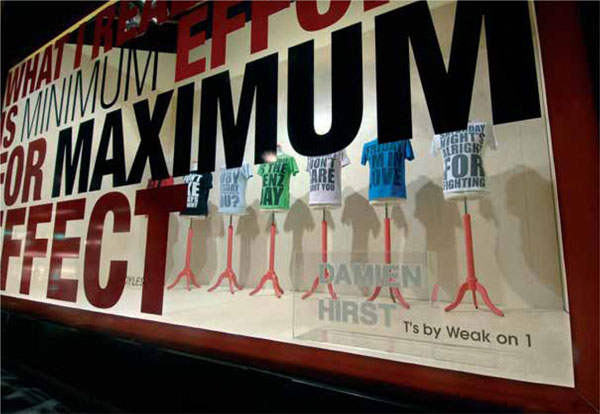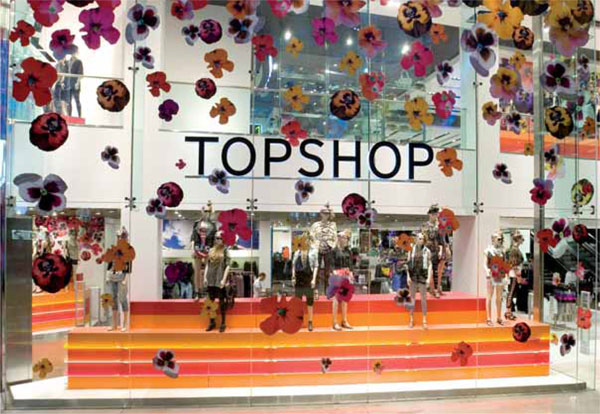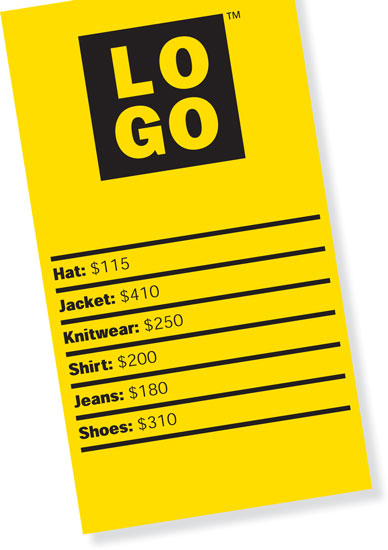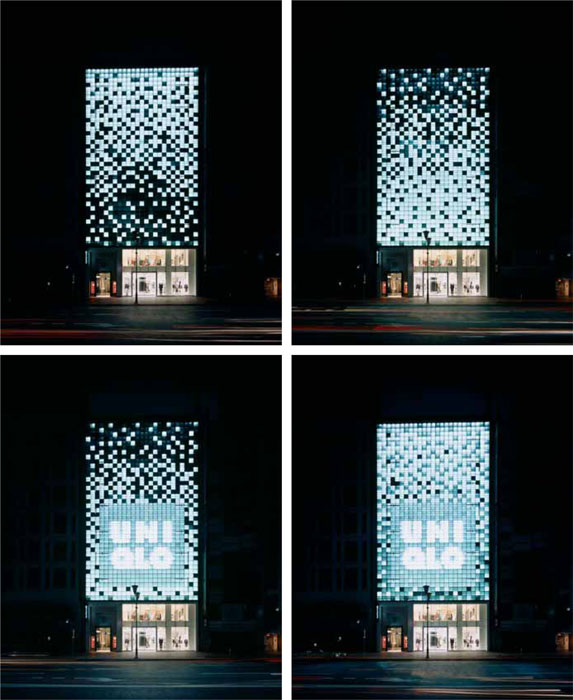Signage and graphics

Part of a sequence of windows entitled “Spring Beauty” at Selfridges, London. The text is the theme that runs through each window, each caption relating to a recognizable quotation or colloquialism.
There is no doubt that an illustration (graphic) or piece of text (signage) in a window is a sure-fire way to get a statement across to customers, be it price-driven or informative. Many visual merchandisers not only use graphics to tell a message but also as part of their window schemes. The use of bold, colorful text can enhance many window displays. Often, signage and graphics may be used as a statement to support the window theme, or sometimes as the prop that ties a window scheme together.
Signage
It is worth noting that too much information can be confusing and text should be used cautiously. It is rather arrogant to expect shoppers to read reams of text in a window. It is always best to keep any text simple and explanatory; punchy one-liners always work best. Window signage should be planned at the same time as the scheme or theme—it should never be an afterthought. Always consider how the signage interacts with the window scheme or products, and question whether the text enhances the window or if it is unnecessary. Any signage used in a window should always be prioritized in order of importance. A tag showing the price of an item of furniture may be more important to its sale than a sign stating its location in-store, while a banner offering a discount may overrule both. Either way, too many tags, signs, or graphics can lead to visual overkill.
The positioning of signage and the choice of color must be thoroughly planned beforehand. A green message carefully placed on the glass will not stand out against a green back wall; a contrasting color would work better. The same sign placed directly in front of the main grouping can either hide it or, if positioned correctly, draw the eye to it. Many retailers still place signage far too high in a window and expect the public to look up to read it. Positioning signage high in a window encourages the viewer’s eye to leave the main focus of the window and trail off to the ceiling grid instead. The most common and conventional place for signage is at eye level from the street.
Graffiti, neon, TV screens and projected images may all be used to send messages to the public, and the same general rules apply. To get the message across, text must be clear and easy to read and digest.

Large-scale text is applied to the windows here to create not only a larger window scheme called “Shop Like a Man,” but also to interact with the T-shirts on display.

A colorful window in Topshop, Westfield, London. Giant pansies decorate the two-story facade of the store. The large plinth in co-ordinating colors with neon trim elevates the mannequins.

The impressive backdrop of this window display in Topshop, London, is constructed of steel. The letters have been cut out so that they appear rough and industrial-looking. Backlighting helps the text stand out.
Window signage
Window signage has progressed considerably over recent years. The once handwritten signs hanging from ceiling grids have been replaced with vinyl machine-cut letters that are usually stuck to the window glass. These state-of-the-art letters are accurately cut to a predetermined design by machine and can be produced in any color or typeface. Applying the text to the window, unfortunately, still has to be done by hand. There are many companies that will not only cut the signage for you but also apply it. The task itself is not difficult; however, patience will be required. One small slip and the lettering can fold back on itself and become ruined. The vinyl letters can be positioned on the outside of the window or inside. Both are suitable, although bored customers have been known to pick the letters off the outside of the glass.
To apply the letters, a piece of masking tape is placed on the non-sticky side of the text. This holds the text in its correct format and makes the whole line or word easier to handle. Before placing the text onto the glass, many professionals will spray the glass with a weak soapy liquid; the vinyl lettering is then placed on the glass and the soapy water allows the lettering to be adjusted. When the text is positioned in the correct place, a plastic squeegee the size of a credit card is used to press down the letters and force the water from between the adhesive and the window glass. Finally, the masking tape is carefully pealed off, leaving the text firmly stuck to the glass. When the text is no longer required, it can simply be scraped away with a sharp blade.
The same vinyl treatment can be applied to the entire glass, thus blocking off the window completely. As strange as it may seem that a book teaching the art of window dressing should encourage such an idea, there may be times when a retailer needs to spend days, not hours, re-dressing a window. Many large department stores will use this opportunity to maximize the value of their window space and inform the public of the new window scheme or promotion at the same time. The windows act as a temporary billboard and hide the disarray inside.
Descriptive signs
Descriptive signs are used to inform the customer of prices, location of products, or discounts. While many retailers prefer to be discreet and not inform the shopper of the price of an item, others proudly list the prices adjacent to the merchandise. When pricing the clothing on a mannequin, the sign should always read from top to bottom, listing the prices starting from the top as the mannequin is dressed: i.e. hat, shirt, trousers, shoes. The lettering should be large enough to be seen from outside the window and be positioned to the right of the mannequin. Each pricing sign in the window should be the same size and format. Some retailers use a Perspex stand to hold the sign, which can be purchased from display companies. Because of the static electricity in Perspex, however, such stands can act as a dust magnet and will need to be cleaned daily.
Merchandise can be priced in other ways, too. Smaller price tags may be pinned to clothing items, or housewares may have small signs placed among the groupings. Some items may need a description of the item to help the sale. An antique chair may require a brief history and list of the materials used in its construction; however, an edited version will suit most customers.
Handwritten signs are definitely frowned upon in the visual merchandiser’s world; even the smartest handwriting will look unprofessional. A printed sign will always look better and be easier to read.


French Connection’s larger-than-life vinyl graphics dominate the facade of the London store and promote the season’s trends.
Graphics
Photography, either displayed within or applied to the window itself, is now a common tool of the visual merchandiser. Modern digital technology has made large-scale photographic prints affordable and accessible. As well as being used in conjunction with the retailer’s advertising campaign, images are often created specifically for a window scheme. Such graphics have the advantage of being easy to install—and, as they don’t have to be stored, easily thrown away. Photographic images can be applied to heavy-duty paper or card and hung from the lighting grid, printed on vinyl and applied to the window, or printed on paper and stuck on the back wall. They can create an immediate window scheme that needs little advance planning and is quick to install. More than one skilled person will be needed to apply large-scale vinyl graphics to the glass. Care should be used in positioning them in the window. Ideally, they should not be applied to the side walls as they will only be seen by customers passing the window in one direction. Positioned on the back wall, however, they can be used to attract the eye into the window.

This impressive approach uses the store brand as part of the building’s design at Uniqlo in Tokyo.
